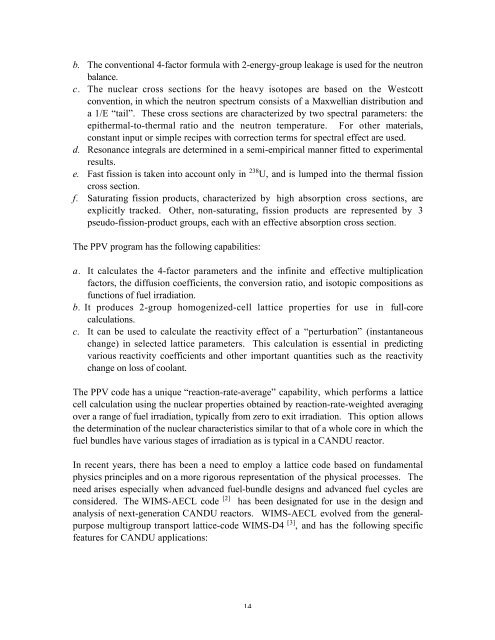Physics Codes and Methods for CANDU Reactor by ... - Basic Search
Physics Codes and Methods for CANDU Reactor by ... - Basic Search
Physics Codes and Methods for CANDU Reactor by ... - Basic Search
You also want an ePaper? Increase the reach of your titles
YUMPU automatically turns print PDFs into web optimized ePapers that Google loves.
. The conventional 4-factor <strong>for</strong>mula with 2-energy-group leakage is used <strong>for</strong> the neutronbalance.c. The nuclear cross sections <strong>for</strong> the heavy isotopes are based on the Westcottconvention, in which the neutron spectrum consists of a Maxwellian distribution <strong>and</strong>a 1/E “tail”. These cross sections are characterized <strong>by</strong> two spectral parameters: theepithermal-to-thermal ratio <strong>and</strong> the neutron temperature. For other materials,constant input or simple recipes with correction terms <strong>for</strong> spectral effect are used.d. Resonance integrals are determined in a semi-empirical manner fitted to experimentalresults.e. Fast fission is taken into account only in 238 U, <strong>and</strong> is lumped into the thermal fissioncross section.f. Saturating fission products, characterized <strong>by</strong> high absorption cross sections, areexplicitly tracked. Other, non-saturating, fission products are represented <strong>by</strong> 3pseudo-fission-product groups, each with an effective absorption cross section.The PPV program has the following capabilities:a. It calculates the 4-factor parameters <strong>and</strong> the infinite <strong>and</strong> effective multiplicationfactors, the diffusion coefficients, the conversion ratio, <strong>and</strong> isotopic compositions asfunctions of fuel irradiation.b. It produces 2-group homogenized-cell lattice properties <strong>for</strong> use in full-corecalculations.c. It can be used to calculate the reactivity effect of a “perturbation” (instantaneouschange) in selected lattice parameters. This calculation is essential in predictingvarious reactivity coefficients <strong>and</strong> other important quantities such as the reactivitychange on loss of coolant.The PPV code has a unique “reaction-rate-average” capability, which per<strong>for</strong>ms a latticecell calculation using the nuclear properties obtained <strong>by</strong> reaction-rate-weighted averagingover a range of fuel irradiation, typically from zero to exit irradiation. This option allowsthe determination of the nuclear characteristics similar to that of a whole core in which thefuel bundles have various stages of irradiation as is typical in a <strong>CANDU</strong> reactor.In recent years, there has been a need to employ a lattice code based on fundamentalphysics principles <strong>and</strong> on a more rigorous representation of the physical processes. Theneed arises especially when advanced fuel-bundle designs <strong>and</strong> advanced fuel cycles areconsidered. The WIMS-AECL code [2] has been designated <strong>for</strong> use in the design <strong>and</strong>analysis of next-generation <strong>CANDU</strong> reactors. WIMS-AECL evolved from the generalpurposemultigroup transport lattice-code WIMS-D4 [3] , <strong>and</strong> has the following specificfeatures <strong>for</strong> <strong>CANDU</strong> applications:14
















